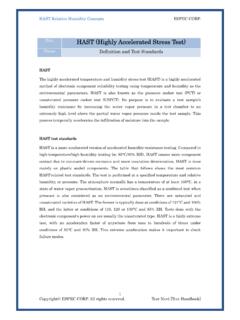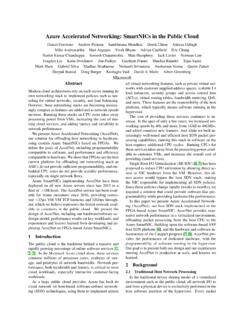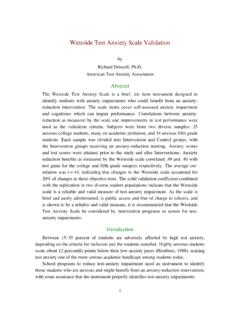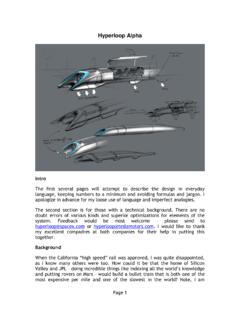Transcription of Environmental Protection Agency Wastewater Technology …
1 United StatesEnvironmental ProtectionAgencyWastewater Technology Fact SheetScreening and Grit RemovalDESCRIPTIONW astewater contains large solids and grit that caninterfere with treatment processes or cause unduemechanical wear and increased maintenance onwastewater treatment equipment. To minimizepotential problems, these materials require separatehandling. Preliminary treatment removes theseconstituents from the influent treatment consists of screening, gritremoval, septage handling, odor control, and flowequalization. This fact sheet discusses screeningand grit is the first unit operation used atwastewater treatment plants (WWTPs). Screeningremoves objects such as rags, paper, plastics, andmetals to prevent damage and clogging ofdownstream equipment, piping, and modern Wastewater treatment plants use bothcoarse screens and fine screens. Figure 1 depicts atypical bar screen (a type of coarse screen).Coarse ScreensCoarse screens remove large solids, rags, and debrisfrom Wastewater , and typically have openings of 6mm ( in) or larger.
2 Types of coarse screensinclude mechanically and manually cleaned barscreens, including trash racks. Table 1 describes thevarious types of coarse ScreensFine screens are typically used to remove materialthat may create operation and maintenance problemsin downstream processes, particularly in systemsthat lack primary treatment. Typical opening sizesfor fine screens are to 6 mm ( to in).Very fine screens with openings of to mm( to in) placed after coarse or fine screenscan reduce suspended solids to levels near thoseachieved by primary and GrindersProcessing coarse solids reduces their size so theycan be removed during downstream treatmentoperations, such as primary clarification, where bothfloating and settleable solids are and grinding devices are installed inthe Wastewater flow channel to grind and shredmaterial up to 6 to 19 mm ( to in) in consist of a rotating slotted cylinderthrough which Wastewater flow passes.
3 Solids thatare too large to pass through the slots are cut byblades as the cylinder rotates, reducing their sizeuntil they pass through the slot consist of two sets of counterrotating,intermeshing cutters that trap and shear wastewatersolids into a consistent particle size, typically 6 mm( in). The cutters are mounted on two driveSource: Qasim, 1 CABLE OPERATED BARSCREEN shafts with intermediate spacers. The shaftscounterrotate at different speeds to clean the 2 depicts a channel Wastewater chopping action of the grinder reduces theformation of rag balls and rag ropes (aninherent problem with comminutors). Wastewatersthat contain large quantities of rags and solids, suchas prison wastewaters, utilize grinders downstreamfrom coarse screens to help prevent frequentjamming and excessive RemovalGrit includes sand, gravel, cinder, or other heavysolid materials that are heavier (higher specificgravity) than the organic biodegradable solids in thewastewater.
4 Grit also includes eggshells, bonechips, seeds, coffee grounds, and large organicparticles, such as food waste. Removal of gritprevents unnecessary abrasion and wear ofmechanical equipment, grit deposition in pipelinesand channels, and accumulation of grit in anaerobicdigesters and aeration basins. Grit removalfacilities typically precede primary clarification, andfollow screening and comminution. This preventslarge solids from interfering with grit handlingequipment. In secondary treatment plants withoutprimary clarification, grit removal should precedeaeration (Metcalf & Eddy, 1991).Many types of grit removal systems exist, includingaerated grit chambers, vortex-type (paddle or jet-induced vortex) grit removal systems, detritus tanks(short-term sedimentation basins), horizontal flowgrit chambers (velocity-controlled channel), andhydrocyclones (cyclonic inertial separation).Various factors must be taken into considerationwhen selecting a grit removal process, including thequantity and characteristics of grit, potential adverseeffects on downstream processes, head lossrequirements, space requirements, removalefficiency, organic content, and cost.
5 The type ofgrit removal system chosen for a specific facilityshould be the one that best balances these differentconsiderations. Specifics on the different types ofgrit removal systems are provided Grit ChamberIn aerated grit chambers, grit is removed by causingthe Wastewater to flow in a spiral pattern, as shownSource: WEF, 2 Wastewater GRINDER:CHANNEL UNITTABLE 1 DESCRIPTION OF COARSESCREENSS creen TypeDescriptionTrash RackDesigned to prevent logs, timbers,stumps, and other large debris fromentering treatment size: 38 to 150 mm ( in)ManuallyCleaned BarScreenDesigned to remove large solids, rags,and size: 30 to 50 mm (1 to 2 in)Bars set at 30 to 45 degrees fromvertical to facilitate used in older or smallertreatment facilities, or in BarScreenDesigned to remove large solids, rags,and size: 6 to 38 mm ( to ).Bars set at 0 to 30 degrees always used in newinstallations because of large numberof advantages relative to : Design of Municipal Wastewater Treatment Plants,WEF MOP 8, Fourth Edition, Figure 3.
6 Air is introduced in the grit chamberalong one side, causing a perpendicular spiralvelocity pattern to flow through the tank. Heavierparticles are accelerated and diverge from thestreamlines, dropping to the bottom of the tank,while lighter organic particles are suspended andeventually carried out of the Grit ChamberThe vortex-type grit chamber consists of acylindrical tank in which the flow enterstangentially, creating a vortex flow pattern. Gritsettles by gravity into the bottom of the tank (in agrit hopper) while effluent exits at the top of thetank. The grit that settles into the grit hopper maybe removed by a grit pump or an air lift TankA detritus tank (or square tank degritter) is aconstant-level, short-detention settling tank. Thesetanks require a grit-washing step to remove organicmaterial. One design option includes a grit augerand a rake that removes and classifies grit from thegrit Flow Grit ChamberThe horizontal flow grit chamber is the oldest typeof grit removal system.
7 Grit is removed bymaintaining a constant upstream velocity of m/s(1 ft/s). Velocity is controlled by proportionalweirs or rectangular control sections, such asParshall flumes. In this system, heavier gritparticles settle to the bottom of the channel, whilelighter organic particles remain suspended or areresuspended and transported out of the is removed by a conveyor with scrapers,buckets, or plows. Screw conveyors or bucketelevators are used to elevate the grit for washing ordisposal. In smaller plants, grit chambers are oftencleaned systems are typically used to separategrit from organics in grit slurries or to remove gritfrom primary sludge. Hydrocyclones are sometimesused to remove grit and suspended solids directlyfrom Wastewater flow by pumping at a headranging from to 9 m (12 to 30 ft). Heavier gritand suspended solids collect on the sides andbottom of the cyclone due to induced centrifugalforces, while scum and lighter solids are removedfrom the center through the top of the various types of screening and gritremoval devices are available, it is important thatthe proper design be selected for each similarities exist between different types ofequipment for a given process, an improperlyapplied design may result in an inefficient discussed above, most large facilities usemechanically cleaned screening systems to removelarger materials because they reduce labor costs andthey improve flow conditions and screening , only older or smaller treatment facilitiesuse a manually cleaned screen as the primary oronly screening device.
8 A screening compactor isusually situated close to the mechanically cleanedscreen and compacted screenings are conveyed to adumpster or disposal area. However, plantsutilizing mechanically cleaned screens should havea standby screen to put in operation when theprimary screening device is out of service. This isstandard design practice for most newly : Crites and Tchobanoglous, 3 AERATED GRIT CHAMBERThe use of fine screens in preliminary treatment hasexperienced a resurgence in the last 20 years. Suchscreens were a common feature before 1930 buttheir use diminished because of difficulty incleaning oils and grease from the screens. In theearly 1980s, fine screens regained popularitybecause of improved and GrindersComminutors and grinders are used primarily atsmaller treatment facilities (less than 5 MGD) toprocess material between 6 and 19 mm ( in) (WEF, 1998). This shredded materialremains in the Wastewater and is removed indownstream treatment RemovalWhen selecting a grit removal process, the quantityand characteristics of grit and its potential toadversely affect downstream processes areimportant considerations.
9 Other parameters toconsider may include headloss requirements, spacerequirements, removal efficiency, organic content,and AND DISADVANTAGESA dvantagesScreeningManually cleaned screens require little or noequipment maintenance and provide a goodalternative for smaller plants with few cleaned screens tend to have lowerlabor costs than manually cleaned screens and offerthe advantages of improved flow conditions andscreening capture over manually cleaned and GrindersA major advantage of using communitors andgrinders is that removal of grit reduces damage andmaintenance to downstream and grinders also eliminatescreenings handling and disposal, which mayimprove the aesthetics of the plant, reducing odors,flies, and the unsightliness associated withscreenings. Some recently developed grinders canchop, remove, wash, and compact the use of comminutors in cold weather eliminatesthe need to prevent collected screenings fromfreezing.
10 Comminutors and grinders typically havea lower profile than screens, so cost savings can besignificant when the units must be RemovalAerated Grit Chamber Some advantages of aerated grit chambers include: Consistent removal efficiency over a wideflow range. A relatively low putrescible organic contentmay be removed with a well controlled rateof aeration. Performance of downstream units may beimproved by using pre-aeration to reduceseptic conditions in incoming Wastewater . Aerated grit chambers are versatile,allowing for chemical addition, mixing, pre-aeration, and Grit Chamber These systems remove a high percentage offine grit, up to 73 percent of 140-mesh ( in diameter) size. Vortex grit removal systems have aconsistent removal efficiency over a wideflow range. There are no submerged bearings or partsthat require maintenance. The footprint (horizontal dimension) of avortex grit removal system is small relativeto other grit removal systems, making itadvantageous when space is an issue.
















